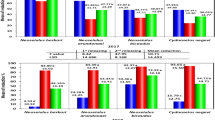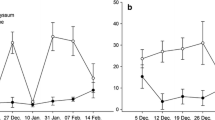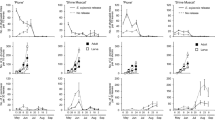Abstract
The green cypress (Cupressus sempervirens) is of great interest for ornamental, reforestation and windbreak use in the whole Mediterranean basin. In Italy, seed material selected for resistance to the fungus Seiridium cardinale is produced in seed orchards by controlled crosses of parent trees. The insect pest showing the highest impact on seed cone production is Pseudococcyx tessulatana (Lep.; Tortricidae), which attacks cones during the initial growth period as well as full-grown cones. The impact on the seed cone crop of the tortricid was estimated on a clone patented for its resistance to cypress canker (Agrimed 1). The attack was inversely related to the cone crop, as it concerned 36.7 % of cones in 1999 (high crop year) and the 66 % in 2000 (low crop year). In both years, about 90 % of the surveyed branches revealed cones attacked by P. tessulatana by the 1st life-cycle larvae, whereas only 40 % of branches were also attacked by the larvae of the 2nd life cycle. The highest attack rate per branch was always observed on branches bearing a low number of cones. The potential of two control methods against P. tessulatana to protect cones which result from crossing a mother tree “Agrimed 1” with selected father trees was also evaluated in 2000. The protection given by a sleeve surrounding the branch was almost complete (0.4 % cone mortality), whereas a cone mortality of 24.3 % was observed on branches treated by the insecticide diflubenzuron. Sleeves appear to be useful to protect branches on which special crosses were done, but are expensive and time-consuming and may favour the attack of the mealybug Planococcus vovae inside the sleeve. The insecticide application may represent a valid alternative, especially when protection should be directed toward a high number of branches.
Similar content being viewed by others
Author information
Authors and Affiliations
Corresponding author
Rights and permissions
About this article
Cite this article
Cantini, R., Battisti, A. Impact and control of the cone tortricid Pseudococcyx tessulatana (Staudinger), damaging the cone crop of a selected clone of cypress (Cupressus sempervirens L.) in Italy. Anzeiger fÜr SchÄdlingskunde/J. Pest Science 74, 107–110 (2001). https://doi.org/10.1046/j.1439-0280.2001.01021.x
Issue Date:
DOI: https://doi.org/10.1046/j.1439-0280.2001.01021.x




